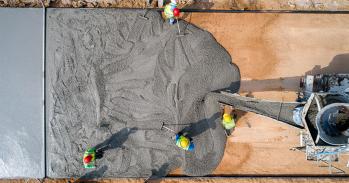
Wood is one of the oldest building materials but its use is limited by its properties. With new funding, researchers aim to stretch these properties to an unprecedented degree, creating the means to build a skyscraper out of plants.
Wood is one of the oldest building materials but its use is limited by its properties. With new funding, researchers aim to stretch these properties to an unprecedented degree, creating the means to build a skyscraper out of plants.
Although the techniques to manipulate manufactured materials are better understood, the potential to generate materials with diverse properties based on plants may be far greater
Michael Ramage
It’s not often that research begins with designing a wooden 70-storey office building that falls over, at least on paper. But this is what a group of architectural engineers in Cambridge did to demonstrate that wood is simply not up to the task.
Today, almost all new large-scale buildings are constructed using concrete and steel. Valued for their strength, flexibility and stability, these materials are nonetheless notoriously energy-intensive, with the manufacturing of construction materials for buildings suggested to account for around 5% of total UK emissions. Indeed, CO2 emissions embodied in how the fabric of the building is constructed can be just as significant as the operational emissions once it is occupied.
“It’s doubtful that much can be done to bring down the energy used in traditional manufacturing of concrete and steel. Primary savings will come only through demand reduction, including switching to other materials,” explained Michael Ramage, the architect behind the experimental wooden skyscraper. “We think there are tremendous opportunities for novel plant-based materials in construction but, as our skyscraper showed, the material itself must be redesigned.
“Forensic engineering showed that once our test building reached a certain height the wood at the bottom began to crush. We want to redesign wood from the molecular level to create some of the most advanced and sustainable construction materials known.”
It’s a compelling vision, and one that will require the combined efforts not just of architects and engineers, but also of plant biochemists, polymer chemists and experts in fluid mechanics. The ambitious five-year project aims to “fundamentally transform the way we build” and is led by Ramage from the Department of Architecture with £1.75 million funding from the Leverhulme Trust.
“There are more varieties of plants than there are of manufactured materials,” added Ramage. “Although the techniques to manipulate manufactured materials are better understood, the potential to generate materials with diverse properties based on plants may be far greater.”
Plants derive much of their strength from the rigid cellulose wall that surrounds each cell. What if this could be engineered to have even greater strength, rather like reinforcing steel bars are used to improve the tensile strength of concrete?

Team member Professor Paul Dupree from the Department of Biochemistry is an expert in understanding how plant cell walls are built. Although this structure forms one of the largest biomasses on Earth, many fundamental aspects of its structure and function, and the enzymes responsible for its synthesis, have largely been a mystery.
Dupree’s work focuses on improving the efficiency of using plants as biofuels by determining how to release the myriad of sugars locked into the cell wall. By deciphering how to unbuild cell walls, he is also gaining understanding of how they can be built better. Ultimately, the researchers would like to understand the process enough to be able to breed or genetically engineer plants that are naturally stronger.
Meanwhile, pioneering work by Ramage and Dr Oren Scherman, in the Department of Chemistry, is looking at boosting the strength, stiffness and longevity of plant-based materials by impregnating them with polymers. Their aim is to use low-value, fast-growing species like spruce and bamboo (see panel) in tall buildings. For instance, they have shown that impregnation of spruce by soaking in methacrylate, a polymer commonly used in windscreen repair kits, can increase spruce’s strength and resistance to fungal attack.
This technology could be used to construct polymer-modified wooden beams that are stronger at the ends for better connections, and stiffer in the middle for greater spans. Scherman, Ramage and Dupree will work together to understand where the polymers end up in the plant cell and what this means for improving structural properties.
And it’s not just structural construction materials that the researchers have in mind. They hope to uncover a range of uses and scales of modified natural materials that improve the sustainability of the way we live, including new materials that moderate temperature and humidity in buildings.
The expertise of Professor Paul Linden from the Department of Applied Mathematics and Theoretical Physics will be crucial for this – his group develops models of the fluid flow in low-energy buildings, which will be used to optimise the mechanical and environmental properties of naturally-based building materials. The aim is to construct buildings that not only use materials that have low embodied energy but also consume as little energy as possible when they are used. “Our ideas are a step towards ‘living differently’,” explained Ramage. “It’s a vision that can only be achieved by strong multi-disciplinary connectivity.”
The research programme fuses fundamental and applied sciences, and is firmly connected with industrial applications. Team member Dr Beatrix Schlarb-Ridley, along with Dr Brenda Parker in the Department of Plant Sciences, supports companies in the East of England in taking up low-carbon solutions based on plant materials as part of the InCrops Project. The researchers hope that this interaction will provide a continuous flow of practical ideas into the project and facilitate the transfer of new technologies into industry.
“Effectively we are working from micro to mega,” summed up Ramage. “We want to redesign natural materials to carry out different functions that will change the way we construct cities. This starts at the molecular level and continues to engineered solutions to sustainable living. Our work will show a way for improved natural materials that are better for people, and better for the planet.”
And as the project nears completion, Ramage and colleagues aim to return to their plans for a 70-storey skyscraper made of wood, and show this time that it can work.
Onset image: Bamboo I-beam; credit: Michael Ramage.
High and mighty: the new bamboo
At the World Conference on Timber Engineering this August, Michael Ramage will present research on new engineering products based on bamboo, a material that has been used to construct houses for thousands of years.
As a building material, bamboo makes great sense. It’s cheap, renewable, is found in areas of the world where structural timber is limited and it grows faster than wood. Little wonder then that new forms of laminated and resin-impregnated bamboo are emerging as building materials.
“Bamboo has captured the imagination of engineers and architects worldwide, but its use has been limited largely because the material shows variations in its geometry and structural properties,” explained Ramage. “Full acceptance of these materials has been hindered by a lack of engineering data on which regulatory bodies can base building standards.”
With funding from the Engineering and Physical Sciences Research Council, Ramage and colleagues have been investigating the properties of bamboo products. He has been working with the independent consultancy Cambridge Architectural Research Limited, and in collaboration with the Massachusetts Institute of Technology and the University of British Colombia.
Their preliminary results have shown that some mechanical properties were similar to those of timber (such as stiffness), but others, like tensile strength, are up to five times greater. This suggests that bamboo might even be used to replace steel eventually, as Ramage explained: “We think that with some slightly more advanced engineering we can reconstitute bamboo into shapes like the rolled steel joists, or I-beams, used in buildings. The time has come to exploit bamboo to its full potential as a durable, strong and beautiful material.”
The text in this work is licensed under a Creative Commons Licence. If you use this content on your site please link back to this page. For image rights, please see the credits associated with each individual image.





